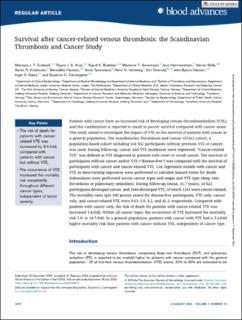Survival after cancer-related venous thrombosis: the Scandinavian Thrombosis and Cancer Study
| dc.contributor.author | Crobach, Monique J.T. | |
| dc.contributor.author | Anijs, Rayna J.S. | |
| dc.contributor.author | Brækkan, Sigrid Kufaas | |
| dc.contributor.author | Severinsen, Marianne T. | |
| dc.contributor.author | Hammerstrøm, Jens | |
| dc.contributor.author | Skille, Hanne | |
| dc.contributor.author | Kristensen, Søren R. | |
| dc.contributor.author | Paulsen, Benedikte | |
| dc.contributor.author | Tjønneland, Anne | |
| dc.contributor.author | Versteeg, Henri H. | |
| dc.contributor.author | Overvad, Kim | |
| dc.contributor.author | Hansen, John Bjarne | |
| dc.contributor.author | Næss, Inger Anne | |
| dc.contributor.author | Cannegieter, Suzanne C. | |
| dc.date.accessioned | 2023-09-25T12:25:47Z | |
| dc.date.available | 2023-09-25T12:25:47Z | |
| dc.date.created | 2023-09-11T10:48:23Z | |
| dc.date.issued | 2023 | |
| dc.identifier.citation | Blood Advances. 2023, 7 (15), 4072-4079. | en_US |
| dc.identifier.issn | 2473-9529 | |
| dc.identifier.uri | https://hdl.handle.net/11250/3091801 | |
| dc.description.abstract | Patients with cancer have an increased risk of developing venous thromboembolism (VTE), and this combination is reported to result in poorer survival compared with cancer alone. This study aimed to investigate the impact of VTE on the survival of patients with cancer in a general population. The Scandinavian Thrombosis and Cancer (STAC) cohort, a population-based cohort including 144 952 participants without previous VTE or cancer, was used. During follow-up, cancer and VTE incidences were registered. “Cancer-related VTE” was defined as VTE diagnosed in patients with overt or occult cancer. The survival of participants without cancer and/or VTE (“disease-free”) was compared with the survival of participants with cancer and cancer-related VTE. Cox regression models with cancer and VTE as time-varying exposures were performed to calculate hazard ratios for death. Subanalyses were performed across cancer types and stages and VTE type (deep vein thrombosis or pulmonary embolism). During follow-up (mean, 11.7 years), 14 621 participants developed cancer, and 2444 developed VTE, of which 1241 were cancer-related. The mortality rates (per 100 person years) for disease-free participants, VTE only, cancer only, and cancer-related VTE were 0.63, 5.0, 9.2, and 45.3, respectively. Compared with patients with cancer only, the risk of death for patients with cancer-related VTE was increased 3.4-fold. Within all cancer types, the occurrence of VTE increased the mortality risk 2.8- to 14.7-fold. In a general population, patients with cancer with VTE had a 3.4-fold higher mortality risk than patients with cancer without VTE, independent of cancer type. | en_US |
| dc.language.iso | eng | en_US |
| dc.publisher | American Society of Hematology | en_US |
| dc.rights | Attribution-NonCommercial-NoDerivatives 4.0 Internasjonal | * |
| dc.rights.uri | http://creativecommons.org/licenses/by-nc-nd/4.0/deed.no | * |
| dc.title | Survival after cancer-related venous thrombosis: the Scandinavian Thrombosis and Cancer Study | en_US |
| dc.title.alternative | Survival after cancer-related venous thrombosis: the Scandinavian Thrombosis and Cancer Study | en_US |
| dc.type | Peer reviewed | en_US |
| dc.type | Journal article | en_US |
| dc.description.version | publishedVersion | en_US |
| dc.source.pagenumber | 4072-4079 | en_US |
| dc.source.volume | 7 | en_US |
| dc.source.journal | Blood Advances | en_US |
| dc.source.issue | 15 | en_US |
| dc.identifier.doi | 10.1182/bloodadvances.2022009577 | |
| dc.identifier.cristin | 2173895 | |
| cristin.ispublished | true | |
| cristin.fulltext | original | |
| cristin.qualitycode | 1 |
Tilhørende fil(er)
Denne innførselen finnes i følgende samling(er)
-
Institutt for klinisk og molekylær medisin [3588]
-
Publikasjoner fra CRIStin - NTNU [38682]
-
St. Olavs hospital [2578]

